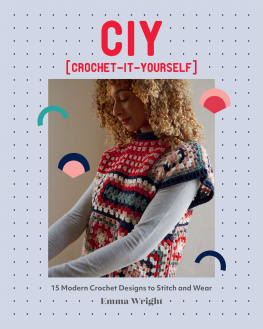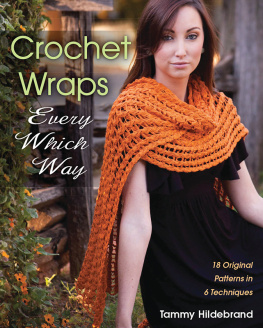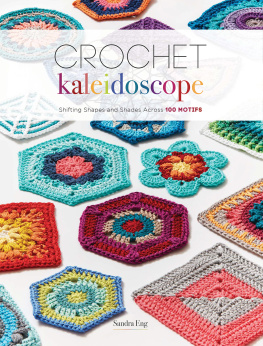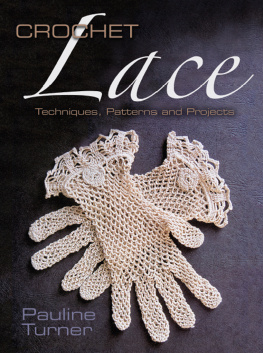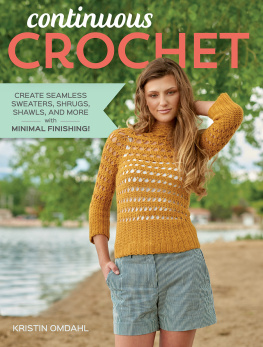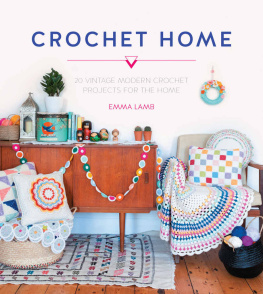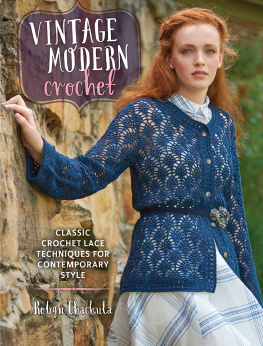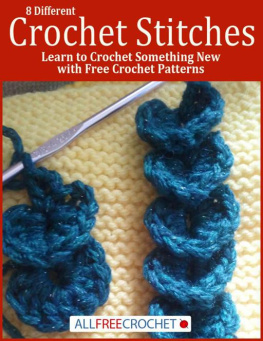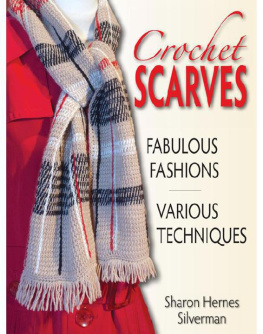Copyright 2013 by Doris Chan
Photographs copyright 2013 by Potter Craft, an imprint of the Crown Publishing Group, a division of Random House, Inc.
All rights reserved.
Published in the United States by Potter Craft, an imprint of the Crown Publishing Group, a division of Random House, Inc., New York.
www.crownpublishing.com
www.pottercraft.com
POTTER CRAFT and colophon is a registered trademark of Random House, Inc.
Library of Congress Cataloging-in-Publication Data
Chan, Doris.
Convertible crochet : customizable designs for stylish garments / Doris
Chan.
Includes index.
1. CrochetingPatterns. 2. Clothing and dress. I. Title.
TT825.C383 2013
746.434dc23
2012021120
Paperback ISBN 978-0-307-96570-7
eBook ISBN: 978-0-307-96571-4
Book and cover design by Karla Baker
Book and cover photographs by Alexandra Grablewski
Technical editing and illustrations by Karen Manthey
v3.1

You wouldnt expect a Venn diagram of the set of people who are avid crocheters and the set of people who are sci-fi geeks to show much overlap. But thats the intersection where youll find me as well as all of you others to whom this book is dedicated.

acknowledgments
Hey, Mom, Harry, and Nick! Cookie, please stop barking. Here we go again.
Incalculable thanks to Karen Manthey, illustrator and technical editor extraordinaire. She makes sense of my work. I forever respect and value her input, expertise, and abilities far beyond those of ordinary mortals.
Much inspiration arrived by way of communing with goddesses. Huge, deep thoughts came through crochet whisperer Vashti Braha, whose genius is shared in her DesigningVashti.com newsletter. Thanks, darlin, for the slip stitch education, for the pants thing, and for the Via, fresh lychees, and Emergen-C. Hugs for Diane Moyer, Tammy Hildebrand, and Suzanne Halstead, who are never too busy to lend an ear.
Full marks and credit to Jane Rimmer, the thread crocheter who dared to boldly go where I would not. Her White Dwarf doily sample is brilliant and her words of encouragement were so helpful.
Deep appreciation to my friends and industry contacts who came through with yarn support, no questions asked: Cari Clement and C. S. Carpenter; Stacy Charles, Diane Friedman, and Debbi Skinner at Tahki Stacy Charles; Jocelyn Tunney at Tunney Wool Company; Lisa Myers at Fairmount Fibers; Valerie Teppo at Blue Sky Alpacas; Lori Goldbach at Kraemer Yarns; Karen Carter at Bryson Distributing; Susan Festa at Knitting Fever; Jonelle and Kat at South West Trading Company; and Norah Gaughan at Berroco and Laura Bryant at Prism Yarns.
To my family at Tulip Company, Japan, Ms. Hyomin Kang, Ms. Kazue Ohara, and Mr. Kotaro Harada, I send my greetings and thanks for the awesome tools.
Thanks to my Potter Craft editor, Betty Wong, for her impeccable taste.
In addition to coffee, I am grateful for geeky sci-fi, Pop-Tarts, and, strangely enough, Spam, all of which aided the authoring process.


preface
QUESTION EVERYTHING
Theres little doubt that I was a born skeptic. My first word was probably Why? followed closely by Why not? and must have been in Cantonese, the only language my parents had in common when they married and the one we used at home until I was five. Very quickly the Doris chatter was punctuated with English words and songs I absorbed while mesmerized by television.
My parents must have been relieved to pack their little skeptic off to school every day, if only to provide them a respite from the incessant stream of questions. Mom and Dad did not have much education, at least not by American school standards, so by the time I finished second grade I had gone beyond being able to get answers at home regarding very important stuff about life, the universe, and everything. My parents steered me toward books. At least I was quiet while reading.
Textbooks contained answers but were so boring. I naturally gravitated toward fiction, especially stories about horses and animals. But one series of childrens books that imagined an animal in space, Ruthven Todds Space Cat , plunged me into my lifelong romance with science fiction. In that era, the genre was filled with ray guns and hypertestosterone action, appealing more to boys. It wasnt until A Wrinkle in Time by Madeleine LEngle that I found a relatable sci-fi story with a girl as the central character. Granted, Meg Murry was a geeky oddball, but then so was I.
Another influential book was Flatland: A Romance of Many Dimensions , the novella by Edwin A. Abbott first published in 1884. On one level Flatland is a satiric commentary on the rigid social structure in Victorian England; on another level it takes you on a mind-bending trip to a world with only two dimensions, where men are polygons and women are straight lines, to a closed society where it is heretical, even illegal, for inhabitants to discuss the existence of a third dimension. So what happens when an observer, a sphere from a three-dimensional parallel world, arrives? Imagine how we would react to an extra-dimensional visitor. It wasnt exactly a fun read, but it caused me to view geometry in a totally different light. Way before muggles, there were Flatlanders.
Although I possessed neither the aptitude nor the discipline to go on to study serious science, which demands rigorous proofs grounded in hard-core mathematics, I have always been drawn to the wonder, mystery, and majesty of the great cosmological ideas that are hinted at in my beloved science fiction. Pop science works such as Carl Sagans Cosmos were eye-opening. Is everything connected? Are we truly made of star stuff, the elements created during the death throes of massive stars in the last infinitesimal fraction of a second before they explode into supernovae? Can it be that space-time is a fabric that folds, bends, and curves and is therefore possible to warp, as in warp drive? All the stuff of science fiction, multiple dimensions, parallel universes, black holes, wormholes, antimatter. For real? Such thoughts not only fueled my imagination, but reinforced the need to question everything, for no great ideas arise unless you look outside the box. In a way, its the skeptical part of my nature coupled with the romance of science and science fiction that led me to design crochet the way I do and to develop the garments for this book.
WHY NOT?
There are no straight lines or flat surfaces on the human body. In order to create crocheted garments that fit human curves, the traditional approach is to treat crochet as you would dressmaking. In the way fabric is exactingly cut into separate pieces according to a drafted pattern and then sewn together, crocheted garments are usually made by creating separate pieces in specific shapes for front, back, sleeve, collar, and ribbing, and then seaming those pieces together. I began to question the wisdom of this method.


